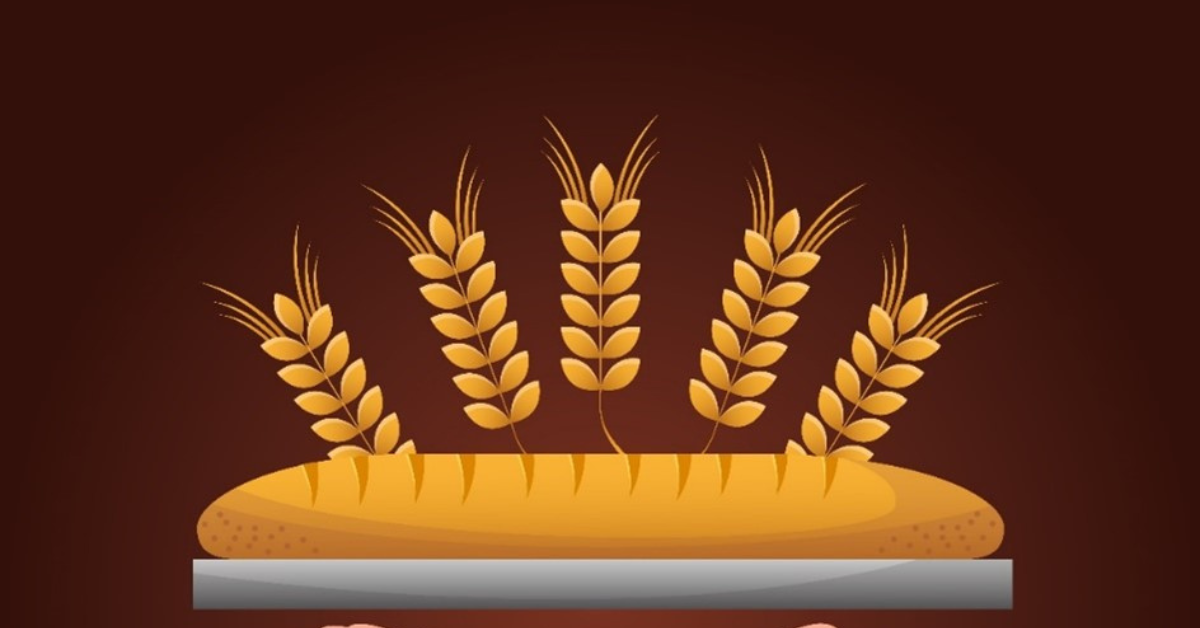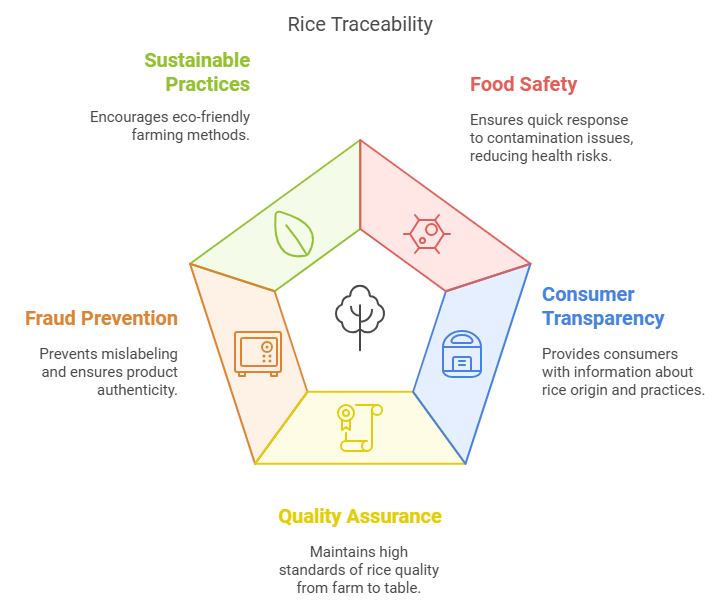Contact: +91 99725 24322 |
Menu
Menu
Quick summary: The volume of rice produced around the world has created a need for a robust system that can track paddy through its journey in the supply chain to ensure safety and security and promote sustainable and climate resilient food production through blockchain traceability solutions.

Traceability in the rice supply chain refers to the ability to track rice from the farm to the final consumer, documenting every stage of production, processing, and distribution. It enables exporters and processors to verify origin, ensure compliance with sustainability standards like SRP, and maintain food safety and quality standards. Digital traceability tools help capture GPS-based farm data, input usage, and batch-level transactions to meet global market requirements.
As global demand for sustainable and ethically sourced food grows, rice—one of the most consumed staples—is under increasing scrutiny. Yet, most rice value chains still operate with fragmented data and limited visibility into farm origins, cultivation practices, or sourcing legitimacy. This lack of traceability exposes exporters and processors to major risks: non-compliance with global regulations, food safety recalls, and even rejection from premium markets.
In this guide, we break down how end-to-end rice traceability works, the digital tools enabling it, and why it’s essential not just for regulatory compliance—but also for future-proofing your brand in a fast-evolving agri-trade landscape.
Key Takeaways
Traceability in the rice supply chain means tracking rice from farm to export with complete transparency—covering farmer registration, GPS plot mapping, input use, harvest, milling, and distribution. It’s crucial for rice exporters to comply with sustainability standards, and access premium markets. However, the process is complex due to fragmented supply chains, smallholder data gaps, and manual recordkeeping.
Sustainable rice cultivation requires traceability to ensure responsible input use, and fair labor practices. That’s where TraceX’s Farm Management Platform comes in—enabling end-to-end digital traceability with farmer onboarding, real-time data capture, multilingual mobile apps, and export-ready audit documentation.
Traceability in the rice supply chain refers to the ability to digitally record, track, and verify the movement and transformation of rice—from the farm where it is grown to the final product delivered to retailers or consumers. For exporters, millers, and aggregators, traceability means having real-time, verifiable data about where, when, and how rice is produced, processed, and transported.
Together, they offer end-to-end supply chain visibility, which is especially critical in rice due to its widespread cultivation, risk of adulteration, and regulatory sensitivity in high-volume export markets.
The rice supply chain includes multiple interconnected stages—production, aggregation, milling, processing, and distribution. In export-oriented supply chains, global food companies often manage these steps under highly integrated operations, maintaining control from farm to port. However, in many cases, rice supply chains remain fragmented, with independent entities handling processing, trading, and retail distribution. Sometimes, bulk rice suppliers—especially those with their own consumer-facing brands—compete directly with international buyers in retail markets, adding complexity to transparency and accountability.
For rice exporters, traceability is no longer optional—it’s a strategic and compliance necessity. With global regulations ,buyers now demand verified proof of sourcing practices.
Traceability enables exporters to provide verifiable farm-to-fork data, ensuring that each consignment meets sustainability standards such as SRP, organic, Fairtrade, or GlobalG.A.P. certifications. It also:
Furthermore, traceability supports climate-smart agriculture by linking production data to environmental performance—like water use, emissions, and input application. In a world where sustainable sourcing is a brand differentiator, rice exporters need digital traceability to stay compliant, competitive, and credible.
Learn how mill-level traceability and global initiatives like the Sustainable Rice Platform (SRP) are transforming rice supply chains.
Explore how digital tools power compliance, sustainability, and visibility—from farm to mill.
Read our blog on Mill Traceability
Explore the Sustainable Rice Platform & Your Path to SRP Compliance
Sustainable rice cultivation is crucial for balancing food security, environmental protection, and farmer livelihoods. Here’s why it matters:
A leading agribusiness exporter partnered with TraceX’s sustainability platform to transform their basmati rice production process. By implementing sustainable practices, the company successfully reduced environmental impacts such as water usage, carbon emissions, and waste. TraceX’s digital solutions enabled real-time monitoring, improved traceability, and provided transparency across the entire supply chain. As a result, the company not only met international sustainability standards but also set new benchmarks for responsible practices in rice cultivation. This transformation helped the agribusiness enhance its brand reputation, appeal to eco-conscious consumers, and contribute to global sustainability goals.
In the quest for more sustainable rice cultivation, two innovative approaches have gained attention: Direct Seeded Rice (DSR) and the System of Rice Intensification (SRI). Both methods offer a way to reduce water use, cut down on greenhouse gas emissions, and improve crop yields—benefiting farmers and the environment alike. By integrating practices like DSR and SRI, farmers can cut down on water usage, reduce methane emissions, and achieve better productivity—all while protecting the environment. These sustainable methods also align well with broader goals of improving the resilience of rice cultivation against climate change, ensuring that rice farming remains viable and environmentally friendly for generations to come.
The Sustainable Rice Platform (SRP) is a global initiative focused on promoting environmentally-friendly, economically viable, and socially responsible rice production. Launched in 2011, it is led by a coalition of public, private, and civil society organizations, including the United Nations Environment Programme (UNEP) and the International Rice Research Institute (IRRI). The SRP aims to transform the rice sector through standards, tools, and innovative practices that make rice cultivation more sustainable.
The SRP developed a set of standards and performance indicators specifically for sustainable rice cultivation. These standards provide clear guidelines on efficient water management, reducing greenhouse gas emissions, promoting biodiversity, and improving labor conditions. Farmers and producers can use these standards to evaluate and improve their practices, ensuring that their methods meet sustainability goals while maintaining or increasing their productivity.
Despite growing demand for transparency, traceability in rice supply chains faces several ground-level hurdles, especially in regions dominated by smallholder farming and informal networks:
Many rice farmers operate on small, scattered plots with little or no formal documentation. Lack of digitized farm data—such as land ownership, GPS coordinates, or production history—makes it difficult to track rice back to its true source.
Paper-based systems are still widely used for harvest logs, procurement receipts, and transport documentation. These records are prone to being misplaced, damaged, or inconsistent, creating breaks in traceability and increasing the risk of audit failure.
Rice typically changes hands multiple times: from farmer to aggregator, to miller, then trader/exporter. Without a centralized digital platform, it’s nearly impossible to unify traceability data across these disconnected players, resulting in information silos and reduced accountability.
Many stakeholders in rice-growing regions may lack fluency in official documentation languages or may be unfamiliar with digital tools. This makes onboarding, form-filling, and compliance reporting challenging, particularly when dealing with complex regulatory frameworks.
These challenges directly impact a rice exporter’s ability to meet traceability, sustainability, and legal sourcing obligations—putting shipments, certifications, and market access at risk. Digital platforms can bridge these gaps by enabling inclusive, multilingual, and offline-capable traceability solutions.
To ensure full traceability in the rice supply chain, exporters and stakeholders must digitize and monitor key checkpoints from farm to shipment. Here’s how the core components work:
These components collectively allow rice exporters to demonstrate sustainable sourcing, improve supply chain transparency, reduce fraud, and meet sustainability standards demanded by regulators and consumers alike.

TraceX’s digital farm management platform is purpose-built to address the critical traceability bottlenecks faced by rice exporters, aggregators, and processors—especially in smallholder-driven supply chains.
TraceX enables field officers to digitally onboard farmers with KYC, land records, and plot boundaries using mobile devices. Farm plots are geotagged with accurate GPS or polygon coordinates, creating verified, traceable origin data that meets standards like Organic, and SRP.
Discover how leading agri-businesses are using digital geo-mapping to track organic practices, validate farm boundaries, and fast-track certification readiness.
Every stage—from seed distribution and input usage to harvest and procurement—is digitally captured and stored in real time. This eliminates paperwork errors, document loss, and ensures data is version-controlled and audit-ready.
The platform connects farmers, FPOs, aggregators, and mills into one integrated system. Traceability flows seamlessly from field to factory to export, supported by role-based dashboards, batch-level coding, and real-time data sync for full visibility.

TraceX’s mobile app works in local languages and functions offline, making it accessible for rural field staff and farmers. This inclusive design ensures that traceability data can be reliably collected even in remote regions with limited connectivity.
Traceability in the rice supply chain offers a game-changing opportunity for transparency, quality assurance, and sustainability. By embracing traceable practices, stakeholders can ensure food safety, mitigate risks, empower farmers, and foster a resilient, ethical supply chain that benefits everyone from farm to fork. Investing in traceability is more than compliance; it’s a commitment to building a better, more sustainable future for rice production.
Traceability ensures transparency, food safety, and authenticity in the rice supply chain by tracking every step of the journey, from farm to consumer, minimizing risks and ensuring compliance.
It helps combat issues like fraud, quality inconsistencies, contamination risks, and inefficiencies by offering clear visibility into every stage of production and supply.
Farmers gain access to premium markets, improved income, better recognition for sustainable practices, and data-driven insights for optimizing their production processes.
Explore how blockchain ensures transparency, trust, and tamper-proof traceability across food supply chains.
Is Blockchain the Future of Food Traceability?
Discover how a digital farm management system boosts productivity and sustainability from seed to harvest.
Building a Sustainable Future with Farm Management Systems
Not all platforms are created equal. Here’s what agri-businesses should evaluate before investing in a traceability system.
Choosing the Right Traceability Solution: What Really Matters?
